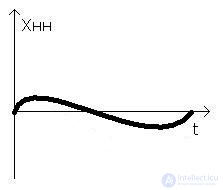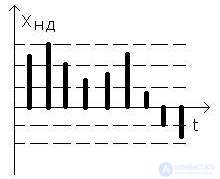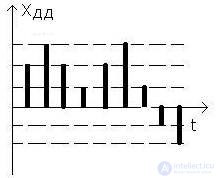Lecture
In general, information is an abstract concept, the value of which depends on the context in which it is used. The most general definition of information takes place in philosophy, where information is one of the attributes of matter, reflecting its structure. In this course, under the information we will understand all the information that is the object of storage, transmission and conversion. In turn, information is knowledge expressed in signals, messages, news, notifications, etc.
Information can be expressed in a variety of forms. According to the type of perception, among them are the following, the most commonly used forms of presenting information:
- graphic or pictorial - paintings, photos, drawings,
holograms, various types of real world, such as the northern lights,
maps, etc.
- sound - the world is full of sounds that we can perceive either
with your senses, or with the help of instruments, it is speech, music,
infra-low sounds from earthquakes and ultrasounds in technology, and much
other
- text - speech of a person encoded with special characters,
- numeric - quantitative measure of objects and their properties, coded
special characters like text,
- video information - a form of presenting information in the form
frame sequences (graphical form) following each
friend with some frequency
- tactile - a form of presenting information, perceived
when touched or using sensors,
- organoleptic - transmitted through odors, tastes and other organs
human senses, as well as using sensors,
- technical - presentation of information through testimony
a variety of sensors, such as tension sensors
magnetic fields, X-ray machines, andron colliders, etc.
All these forms can be further divided into different types according to the nature of the representation of the parameters:
- static (time independent) and dynamic (variables in
time)
- continuous and discrete in time,
- continuous and discrete in size.
In technology, the concept of information is closely related to concepts such as signal, message, and data.
A signal is any process that carries information (electrical signal in wires, radio signal in the air, light perceived by a telescope, etc.).
A message is information presented in a specific form and intended to be transmitted.
Data is information presented in a formalized form and intended for processing.
A signal is called continuous in time if its parameter within the specified limits can change at any time. A signal is called discrete in time if its parameter within the specified limits can change only at fixed points in time.
A signal is called analog if its parameter within the specified limits can take on any intermediate values at any given time. A signal is called discrete in magnitude and continuous in time if its parameter can take only individual fixed values within the specified limits, but at any time.
A signal is called discrete in magnitude and in time , if its parameter can take only individual fixed values within specified limits, and changes can occur only at fixed points in time.
Figure 1.1 in the form of graphs depicts:
a) analog (continuous level and in time) signal HNN;
6) discrete in level and continuous in time signal Hdn;
c) continuous level and discrete in time signal Xnd;
d) discrete by level and in time signal Hdd.
 but but |  b b |
 at at |  g g |
Fig.1.1. Different types of signals
The form of presenting information is very important in its transmission and perception, because depending on the goal that you set for yourself, the same information can be presented in different forms.
Since information means all information that is the object of storage, transmission, and transformation, languages are used for uniqueness in the implementation of these processes.
The basis of any language is the alphabet - a set of uniquely defined characters (symbols), through which information is presented.
Languages are divided into natural (spoken) and formal. The alphabet of natural languages depends on national traditions. Formal languages are found in special areas of human activity (mathematics, physics, chemistry, computer technology, etc.).
Representation of information using a formal language is called coding.
Code - a set of symbols (symbols) for the presentation of information. Encoding is the process of presenting information in the form of code or, in other words, the process of transforming information from one form to another. Decoding is the reverse of encoding.
The way of presenting information using a language containing only two characters of the alphabet, 0 and 1, was proposed by the famous German scientist Gottfried Wilhelm Leibnitz as early as the 17th century. “Computation using twos ... is the main science for science and generates new discoveries ... when mixing numbers to the simplest beginnings, which are 0 and 1, a wonderful order appears everywhere. ”
Today, this way of presenting information is widely used in technical devices, including computer. These two characters 0 and 1 are called binary numbers or bits (from the English. Bit - Binary Digit - a binary character). The technical implementation of this alphabet was the most simple:
- in electronic devices, 0 is usually represented by low voltage,
1 - high (positive logic) or vice versa (negative logic),
- in storage devices bistable cells are used, one
the state of which is taken as zero, the second - as one,
- in the fiber-optic communication lines 0 - the absence of a light signal,
1- the presence of a light signal.
A larger unit of measurement of information is considered to be 1 byte, which consists of 8 bits.
It is also customary to use larger units of information. The number 1024 (2 10 ) is a multiplier when moving to a higher unit of measure.
| Kilobit | Kbps = 1024 bits |
| Megabit | 1 Mbps = 1024 Kbps |
| Gigabit | Gbit = 1024 Mbit, |
| Kilobyte | 1 KB = 1024 bytes |
| Megabyte, | 1 MB = 1024 KB, |
| Gigabyte | 1 GB = 1024 MB. |
In the general case, with reference to the binary system, the amount of information is determined by the K. Shannon formula
H = log 2 N,
where H - the amount of information that carries the idea of the state in which the object is located,
N is the number of equally probable alternative states of the object.
Consider ways to present information in the computer.
Representation of integers.
In a computer, different ways of representing integers are possible. The most common is the fixed-point format. If this number is unsigned, then all bits of the memory cell participate in indicating the quantitative value of the number. When the memory cell size is 1 byte, it is possible to represent all numbers in the range from 00000000 to 11111111 (in the binary system) or from 0 to 255 (in the decimal system). The larger size of the memory cell allows you to encode a larger range of numbers. If it is necessary to encode signed numbers, the sign of the number is encoded in the high-order bit of the memory cell, and the modulus of the number is encoded with the remaining bits.
Representation of real numbers.
Real numbers in a computer are represented in both fixed-point and floating-point formats. The fixed-point format assumes that the most significant bit stores the sign of a number, one part of the remaining bits stores the integer part of the number, and the other part the fractional part of the number. Moreover, the ratio of bits for storing the whole and fractional parts is fixed. In the floating-point format, the bits of the memory cell are divided into the following groups: the sign of the number, the mantissa, the sign of the order, the module of the order. For example, with a memory cell length of 32 bits, 1 bit occupies the sign of a number, 24 bits occupies the mantissa of a number, 1 digit occupies a sign of the order of a number, and 7 bits - an order module.
Presentation of textual information.
Text information is represented as a sequence of alphabet characters and service characters. Each character and symbol is assigned a binary number in accordance with the encoding table. There are various standards for encoding text information, for example, KOI-7, ASCII, UCS-2, UCS-4. The frequently used ASCII codepage allows 256 characters of the alphabet and service characters to be encoded with 8-bit codes. Text information is decoded for display. Instead of a digital code, an image of a symbol is displayed on the screen. The full set of symbol images for different alphabets and font types is stored in a special memory area — the character generator.
Presentation of graphic information.
Coding of graphic images is divided into two directions - raster and vector graphics. A raster image is a grid of dots, called pixels (pixel, from the English words picture element). The more pixels, the more detailed the image. A color code is stored in memory for each pixel. The most common is RGB encoding (Red, Green, Blue - red, green, blue). With a 24-bit color code, 8 bits are used to set the intensity of red, 8 bits are green, and another 8 bits are blue. Thus, each color has 256 intensity levels. Mixing these colors in different ratios gives 2 24 different colors. In this form, the graphic information is stored in files with the .bmp extension. To reduce the size of stored files use additional encoding methods - compression. The resulting files have the extension JPEG, GIF, etc.
In the vector representation of graphic information, instead of a grid of points, there is a set of layers. Each layer contains its own element of a vector image - a segment, a curved line or a figure, which are described using a special language (mathematical equations).
For example, for the construction of such a graphic primitive as a circle of radius r, the following source data is necessary and sufficient:
- coordinates of the center of the circle,
- the value of the radius r,
- fill color, if the circle is not transparent,
- color and thickness of the contour in the case of a contour.
Complex graphic objects are represented as a set of elementary graphic objects (graphic primitives). The resulting image is obtained by combining the layers that describe it. Examples of graphic editors that create bitmaps include CorelDRAU, Microsoft Visio, and Adobe Flash.
The main difference between raster and vector graphics is that you can easily move, scale, rotate, fill the vector image without losing quality, since it is actually specified as equations, while the raster image is already defined with finite discreteness (limited number of pixels). ) and its increase leads to an increase in grain.
At the same time, not every object can be easily represented in vector form. For complex objects, it may take too many graphic primitives and a very long time to calculate the image when outputting to a raster display. In particular, the conversion of raster images into a vector form, as a rule, requires a very large amount of computation and does not always ensure the high quality of the vector pattern.
That is, vector graphics are ideal for simple or composite drawings, which should be hardware-independent or do not need photorealism.
Presentation of audio information.
Primary sound signal transducers are sensors.
(microphones) that convert sound to an analog electrical signal. Further, this signal is sampled by time and amplitude (digitized) by special devices - analog-digital converters, and as a sequence of binary numbers enters a computer. The inverse transform is performed by digital-to-analog converters, the output signal of which is smoothed, amplified and fed to the speakers, reproducing sound information. As a rule, information from any sensors converting the most diverse technical information enters the computer in a similar way.
To compress audio information, depending on the nature of the sound, different encoding methods are used. For example, MP3 is often used for music, and multi-code-controlled linear prediction (CELP) is used to encode speech in mobile communications. For coding instrumental music in computers and synthesizers, the MIDI coding system is often used, based on musical notation, which is extremely compact and easy to change the tempo and tone of a melody.
1. What are the known forms of information representation.
2. The separation of forms of presentation of information on the nature of the presentation of parameters.
3. Define concepts such as signal, message, and data.
4. What is the difference in continuous signal from analog.
5. What is the difference between formal and natural languages?
6. Define encoding and decoding.
7. How are integers in a computer.
8. How are real numbers in a computer.
9. Submission of textual information in a computer.
10. Presentation of graphic information in the computer.
11. What is the difference between raster and vector graphics?
12. Presentation of audio information in the computer.
Comments
To leave a comment
Computer circuitry and computer architecture
Terms: Computer circuitry and computer architecture